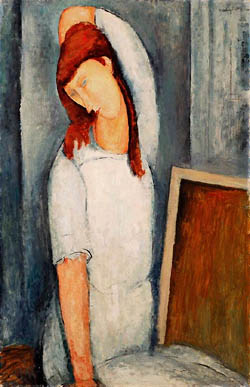The Art of Seeing Art
Version 1.1, © 2007 by Dale Cotton, all rights reserved.
Part 8: The Frolic of Egos
Fame and Fortune
I don't think it is possible to understand the visual arts microcosm without understanding a certain bizarre phenomenon. At least once each year we read of a multi-million-dollar auction sale of some famous work of art. Just as art is anything you can get away with – so the price of art is anything someone is willing to pay for it. Regardless how much the purchaser may covet a particular painting, the key question is whether a given price makes sense as an investment.
But how is it that a square yard of canvas plus a few dollars of pigment and linseed oil can come to literally exceed their weight in gold? What gives gold its value is in small measure its utility and in large measure its scarcity. Ditto, fine art. We can argue that a given Rembrandt displays an unparalleled mastery of the paintbrush together with the mature vision of a fine mind. Can we say the same about the Mark Rothko painting above? What's key here is that collectors are not so much buying a piece of art as they are a piece of history. A single hankerchief used by Marie Antoinette may sell for more money than the purchase price of all the hankerchiefs ever sold to this point in time. When I was growing up, Picasso was still alive, was still spawning paintings, etchings, sculptures, etc. by the thousands, and each one was sold for an exorbitant price. Purchasers were gambling that Picasso's reputation as a "great" painter was not a passing fad but would instead prove to be permanent.
So the question a speculator/collector might ask is: which of the current and undiscovered artists will prove to be the goose that laid the golden eggs, say fifty years from now? Unfortunately, a sea change has taken place in the visual arts which has changed the entire complexion of the problem.
Art used to be done by a very few people who had the means to do so. Good art was rare, like jewels and spices; and photography didn't exist, either. Now between the global population explosion, the prevalence of literacy and education in the first world, and first world affluence there are thousands of truly excellent artists currently alive. There are likely more visual artists actively producing today than there were in all the centuries before today combined. Even if the ratio of "good" artists to "bad" artists has declined (and there's no reason to think this to be the case), scarcity/rarity as a element in the value/price equation is toast.
So, if you want to identify the next big name in visual art, ignore all questions of craftsmanship, visual "genius", and the like. Instead, what you're looking for is marketing genius – whether in the person of the artist herself or in that of her agent. But even that advice really misses the mark. I want you to take a few seconds right now to list five famous artists alive and producing today. Seventy-five years ago, no problem: your list might have included names like Picasso, Dali, Max Parrish, Norman Rockwell, Klee, Kandinsky, etc. But who are their equivalents today?
Congratulations if you've come up with even one name. A few candidates are David Hockney, Robert Bateman, and Thomas Kinkade. There are now so many artists taking their slice of the pie that the thickness of each slice can now only be measured with a micrometer. It would be hard to imagine a better marketing machine than the one Thomas Kinkade has built, yet I doubt more than five percent of all people in the United States would recognize his name, let alone in other countries.
I suspect we are living through a transition period. If we could peek ahead to the art world of 2100 (and assuming humanity and civilization is still around by then), I wouldn't be at all surprised if we'd find that visual art has become so pervasive an amateur activity that the very idea of a professional visual artist will seem quaint.
While this may be bad news for the collector, it is good news for the genuine art lover. Very likely somewhere with in fifty miles of your home there is at least one, and probably several, visual artists doing excellent work for modest prices. If your tastes lean toward craftsmanship and representation rather than imagination and experimentation you may have to search a little harder; but every such purchase you make is a vote in favour of those values.
A simple tip for buying artwork for your home or office: Like a pretty face, some pictures make a very simple, dramatic statement. That's great for a brief fling, but if you want an affair that will last, you might consider looking for a picture with enough complexity that you can't take in all its goodness in a single glance.
Style and Branding
I mentioned above that self-promotion has become the essential skill for the visual artist. And, in what is now the new (anti-)tradition, the crux of self-promotion is to have a unique and identifiable style. But there are two problems with that approach. One: each artist is forced to re-invent the world instead of building upon the progress made by her predecessors. Two: each artist is trapped inside the confines of her chosen style. Amedeo Modigiliani was one of the earlier artists to stylize his work so extremely. He happened to die at a very young age and so may never have felt the pinch. But if you gain a measure of success from having an instantly recognizable and unique style, you cannot not abandon that style without throwing away the marketing advantage you struggled to acquire. In other words, once Jon Dough establishes an identifiable style he is forever trapped into painting Jon Doughs. (Yes: Picasso reinvented himself multiple times without losing market share; but this was because the very name Picasso had become a salable commodity.)
If there should ever be another superstar in the visual arts world, perhaps one way we'll recognize her would be that her success will have come without resorting to stylistic jim-crackery. As one jazz great says about another:
In short, [Coltrane's] tone is beautiful because it is functional. In other words, it is always involved in saying something. You can't separate the means that a man uses to say something from what he ultimately says. Technique is not separated from its content in a great artist.
– Cecil Taylor (quoted in John Coltrane by Bill Cole, p193; source: Wikipedia)
In Part 3 I wrote "The typical non-artist looks through a representational painting or photograph and latches on to its subject matter" and suggested that we consider how an artist renders content, as well as what the content is. Perhaps, having explored technique and rendering, having seen rendering devolve into style, and style into branding, we now need to return to content and ask of a painting whether there is any substance beyond the show.
* * *
– And that concludes our brief excursion into the world of the visual arts. I hope you enjoyed reading it as much as I enjoyed writing it; and I hope a few ideas here and there will stick long enough to see you through your next visit to an art museum or gallery ... whether you go there willingly or no!
If you would like to continue exploring the world of the visual arts without getting up from your computer, one entry point is here.


